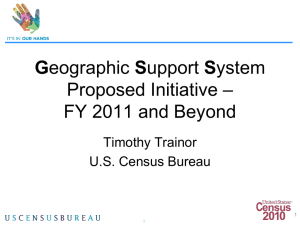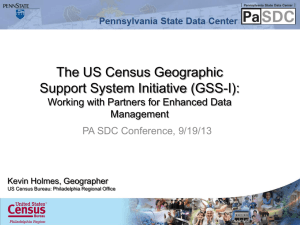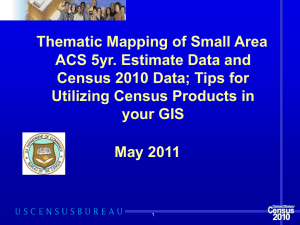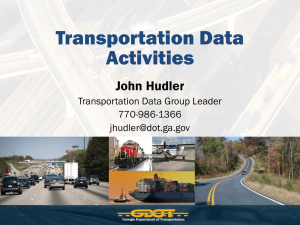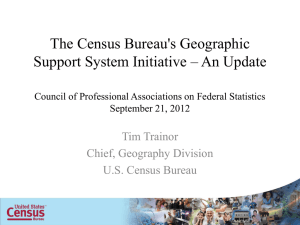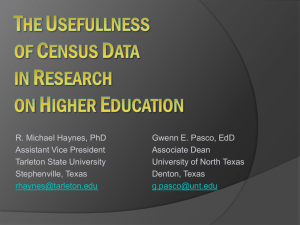Census Geographic Support System Initiative & New Census Products
advertisement
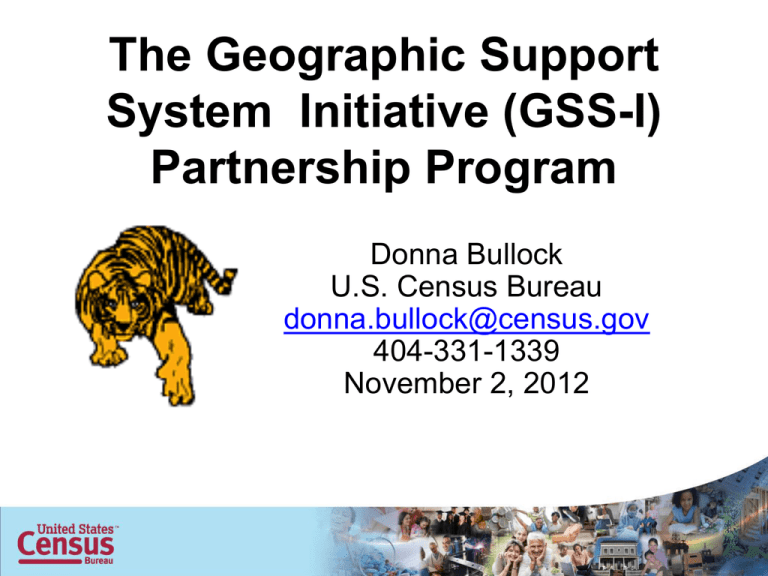
The Geographic Support System Initiative (GSS-I) Partnership Program Donna Bullock U.S. Census Bureau donna.bullock@census.gov 404-331-1339 November 2, 2012 Census Geographic Support – Major Initiatives Over Time For the 1990 Census – Introduced TIGER For the 2000 Census – Introduced the Master Address File For the 2010 Census – conducted the MAF/TIGER Enhancement Program For the 2020 Census – The GSS Initiative What is the GSS Initiative? Address Updates Quality Measurement 123 Testdata Road Anytown, CA 94939 Lat 37 degrees, 9.6 minutes N Lon 119 degrees, 45.1 minutes W • An integrated program consisting of: Improved address coverage Ongoing address and spatial database updates Enhanced quality assessment and measurement Street/Feature Updates Major Components of 2010 Census Address List Development 2010 Address Canvassing Facts • Number of housing unit addresses that needed verification: 145 million • Number of census workers hired for Address Canvassing: 140,000 • Number of hand-held computers used: 151,000 • Number of local census offices that managed operations: 151 • Dates of operation: March 30 - Mid-July 2009 Goal: A Shift in Focus for the 2020 Census • From a complete Address Canvassing to a targeted Address Canvassing – Hinges on establishing an acceptable address list for each level of government 6 Why a “Targeted” Address Canvassing? • $$$! It is VERY expensive – Field an ARMY of address canvassers – “Walk” EVERY street in the nation… • Goal: developing regular update and change detection processes • Result: “Target” only areas with uncertainty – Quality of Addresses – Currency of Addresses Quality Assurance Goals 1: Establish quantitative measures of address and spatial data quality Existing MAF/TIGER Data 3: Monitor and Improve the quality of the: 2: Assign Quality Indicators to MAF/TIGER data Geographic products output from the MTDB IT processes for updating the MTDB Partnerships are Key! • Local governments are the authoritative sources for address and spatial data! • Expanding our Partnerships is Critical – Key step towards establishing an accurate and up-todate address list • The GSS-I Partnership Program seeks government, organizational, and commercial partners willing to share high-quality data on: – Addresses – Housing Unit Structures – Street Centerlines and Attributes What Kind of Address Data? • City-style addresses and/or • Non city-style addresses (i.e., Rural Route #) that “ideally” meet: 1. USPS minimum delivery requirements, and 2. The FGDC Address Standard (U.S. Thoroughfare, Landmark, and Postal Address Data Standard) See the Draft Census Bureau Address Data Content Guidelines: http://www.census.gov/geo/www/gss/gdlns/addgdln.html What Kind of Housing Unit Structure Data? • Latitude/Longitude Coordinates for a Housing Unit structure or access point (i.e., from E-911 or Next-Gen E-911 database) • Structure centroids • Latitude/Longitude Coordinates for a real property parcel or parcel centroid • Other points used by partner? See the Draft Census Bureau Address Data Content Guidelines: http://www.census.gov/geo/www/gss/gdlns/addgdln.html What Kind of Street Feature Data? • Street centerline geometry • Street attributes – names, address ranges, etc. Why? • Expand Census centerline and attribute coverage • Spatially-correct misaligned streets in conjunction with high-quality imagery See also the Draft Census Bureau Feature Data and Metadata Content Guidelines: hhttp://www.census.gov/geo/www/gss/gdlns/addgdln.html GSS-I Progress in last year • Pilot projects from Address Summit (Sept. 2011) • Address Authority Outreach and Data Sharing • FGDC Address Standards and Implementation • Federal/State/Tribal/Local Address Coordination • Data Sharing Model– Local/State/USPS/Census • Hidden/Hard to Capture Addresses • Researched/acquired “test” county data for development of GSS-I processing systems. In AL: Bullock and Shelby. Community TIGER • New tool being developed in partnership with ESRI. • Web-based data sharing/upload system. • Open for all to use; no software license requirements. • Input of state/local/tribal data produces standardized output format used to update MAF/TIGER. • Beta version due in Feb 2013. Planned Schedule • Fiscal Year 2012 (Oct 2011 – Sept 2012) – Process Development, pilot work, research, system development, initiated Community TIGER • October 2012 – Kickoff GSS Partnership Program (~51 partners, TBD) • February 2013 – Start Providing Feedback to Partners • March 2013 – Identify 300-400 supplemental FY13 partners based on quality audit of MAF/TIGER data – Community TIGER beta testing • October 2013 – Planning for open participation! New Geographic Products • TIGERweb v2.0: WMS and viewer app with 2010, 2011, and more geographic area vintages <WFS coming soon…?> http://tigerweb.geo.census.gov/tigerwebmain/tigerweb_main.html • 2012 TIGER/Line Shapefiles: http://www.census.gov/geo/www/tiger/index.html • 2010 Geodatabases and shapefiles pre-joined with 2010 SF1 Demographics: http://www.census.gov/geo/www/tiger/tgrshp2010/2010DP1.html • KMLs for 2010 Counties and Census Tracts: http://www.census.gov/geo/www/tiger/kml/kml.html • 2010 Urbanized Areas, Urban Clusters, and “rural” areas: ftp://ftp2.census.gov/geo/tiger/TIGER2010/UA/2010/ • 2010 Block shapefiles pre-joined with population and HU numbers: ftp://ftp2.census.gov/geo/tiger/TIGER2010BLKPOPHU/ • **America’s Economy App (for Android or Apple phones or tablets): http://www.census.gov/mobile/ Questions? Donna Bullock U.S. Census Bureau Atlanta Regional Office donna.bullock@census.gov 404-331-1339 November 2, 2012



